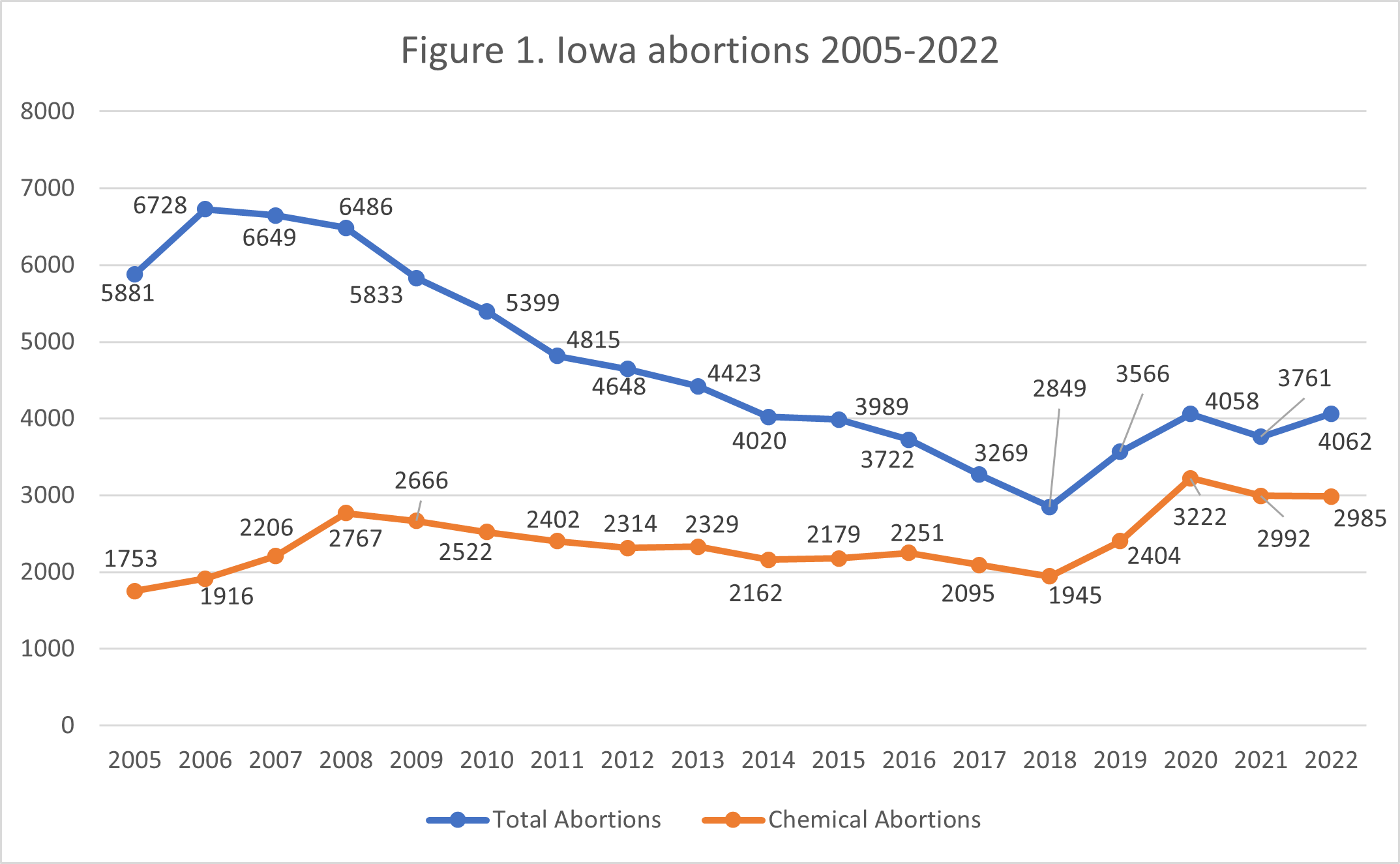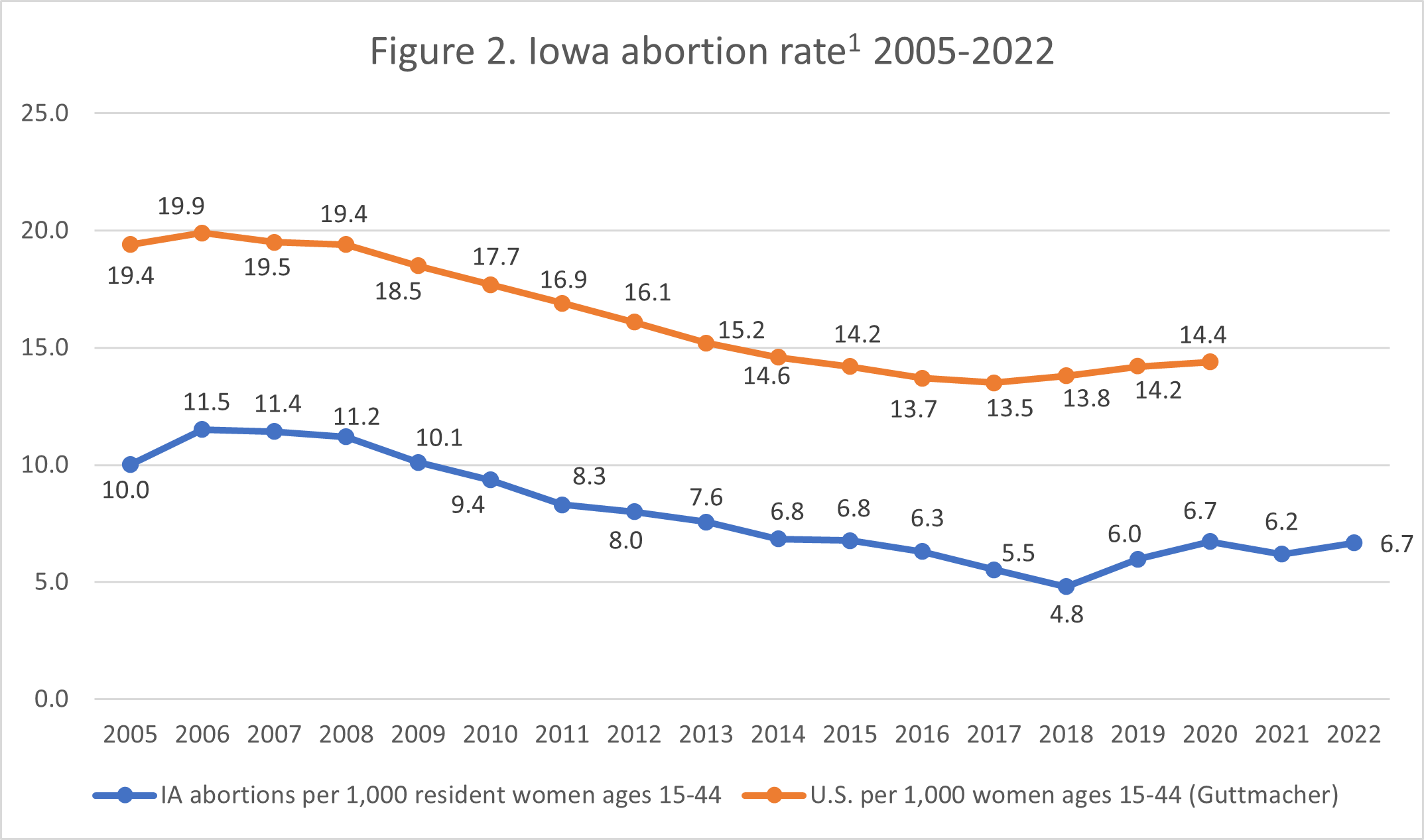Iowa’s 2022 vital statistics report, which includes the state’s abortion statistics, was published online by the Iowa Department of Public Health in October 2023.
Abortion Totals and Trends
There were 4,062 abortions reported in Iowa in 2022, up 8% from 2021 (Fig. 1). Chemical abortions decreased slightly, by 0.2%, but still composed 73% of the total in 2022. Charlotte Lozier Institute (CLI) estimates that Iowa’s abortion rate increased by 8% to 6.7 abortions per 1,000 women ages 15 to 44, a return to the 2020 rate after a decline in 2021 (Fig. 2).1 As of November, 23 states had released 2021 abortion reports, with 13 showing increases in abortion totals from the previous year.
State Report Summary
Eighty-one percent of Iowa abortions were performed on resident women, while 19% were obtained by nonresidents. Eleven percent of the abortions were performed on girls younger than 20, including 3% on girls under the age of 18 and 7% on girls between the ages of 18 and 19. Thirty-one percent of Iowa abortions were performed on women ages 20 to 24, and 26% on women ages 25 to 29. Twenty-nine percent were on women in their thirties, and 3% on women ages 40 or older.
A majority of Iowa abortions, 62%, were obtained by white women. Twenty percent were performed on African American women, and 3% on Asian women. One percent of the abortions were performed on Native American women and nine abortions were on Native Hawaiian or Pacific Islander women, while 7% were on women of multiple races and 6% on women of other or unknown races. CLI estimates that Iowa’s black abortion rate was 25.6 abortions per 1,000 women ages 15 to 44 and five times the white abortion rate of 4.8 abortions per 1,000 women.
Forty-seven percent of Iowa abortions were performed on women who had completed at least some college, and half of the abortions were on women with nine to 12 years of school as their highest level of education. One percent of the abortions were obtained by women with fewer than nine years of education, while education status was not reported for 2% of the abortions. Eighty-six percent of Iowa abortions were on unmarried women, while 14% were on married women. Marital status was not reported for 10 abortions.
HELP LIFENEWS SAVE BABIES FROM ABORTION! Please help LifeNews.com with a donation!
A large majority of Iowa abortions were chemically induced (73%). Twenty-six percent were surgical, and one abortion was performed using some other means. Ninety-three percent of the abortions reported in Iowa occurred in the first trimester, at or before 13 weeks of gestation. Seven percent of the abortions were performed between 14 and 28 weeks of gestation. Zero abortions were reported at 29 weeks or later. The month of March had the most abortions (411), while August had the fewest (261).
Legislative Changes
As CLI previously summarized, Iowa’s 2018 heartbeat law never went into effect after Roe v. Wade was overturned, and abortion remained legal until 22 weeks of gestation (20 weeks post-fertilization). On July 14, 2023, Iowa Governor Kim Reynolds signed HF 732 into law. This legislation prohibits abortion after an unborn child’s heartbeat can be detected except in cases where a mother’s life or physical health is endangered by the pregnancy or in cases of rape and incest. The legislation went into effect immediately but was blocked three days later on July 17, 2023. Abortion remains legal in Iowa up until 22 weeks of gestation.
State Ranking
In 2016, Iowa tied for 33rd best in CLI’s review of abortion reporting across the country. To improve its reporting, Iowa could report gestational age with more specificity instead of grouping together 14 weeks into one range, as CLI has previously recommended. Additionally, Iowa could collect and report abortion complication data, particularly from emergency rooms and other urgent care settings. Chemical abortions have higher rates of complications and emergency room visits than surgical abortions, and as chemical abortions continue to make up a large share of Iowa abortions, chemical abortion-related ER visits are likely to increase.


- National rates were calculated by the Guttmacher Institute. Iowa rates were calculated by CLI using the following formula: (total number of abortions performed in Iowa ÷ number of resident women ages 15-44 [based on most recent population estimates]) x 1,000. Rates may differ slightly from previous CLI articles due to revised population estimates. Population estimates were obtained from the CDC WONDER database. Estimates for 2005-2009 are intercensal estimates of the July 1 resident population. Estimates for 2010-2019 are Vintage 2020 postcensal estimates of the July 1 resident population. Estimates for 2020-2022 are Vintage 2022 postcensal estimates of the July 1 resident population. Estimates were produced by the U.S. Census Bureau and the National Center for Health Statistics.
LifeNews Note: Mia Steupert serves as Research Associate at the Charlotte Lozier Institute, where she conducts and edits research on a variety of topics related to science and statistics for life. Tessa Longbons is a research associate with Susan B. Anthony List’s research arm, Charlotte Lozier Institute.








